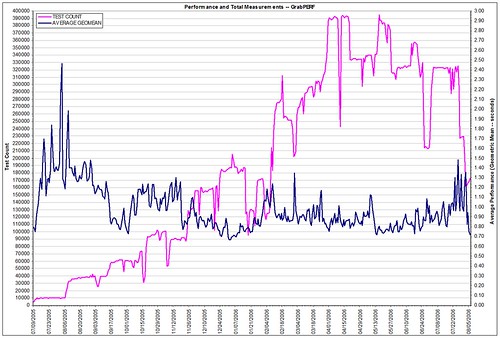Scott Berkun wrote a great post that discusses how he encounters the start-up inflection point in companies. This is the point where the company has to make that brutal transition from the fast-and-loose dynamic of the true start-up to the more established and “normal” business methods.
This week, Niall Kennedy provided an example of someone who gave an established firm a try, but decided that the start-up world is more to his liking.
The object here is not to decide which is best, the start-up or the established firm, but to discuss the transition that occurs when moving between these two phases; and the direction of travel is always one-way, to the established firm. For all their talk of “thinking like a start-up”, established firms are what they are.
I have made this transition twice now. The first time was during the exuberance of the 1999 bubble world with a company that had just gone public. Here the transition was initially hidden by the exponential growth and overly optimistic predictions made by the executives. When reality stepped in early in 2001, the true effect of the transition became clear: this was no longer a start-up, and there were people who were more than willing to make the tough decisions. Whether, in the long-term, these were the correct decisions is a question that I am not willing to answer; I was merely an observer.
I was an observer when a similar change occurred at my current company. A start-up in the sense that it was still a VC-funded private firm, this company had (and still has) an excellent product developed by some top-flight technical talent. The issue now was to take that foundation and build a team that could execute. Again, I can’t say whether the decisions that were made were the correct ones, but the team that was built during that time has lead the company out of the wilderness and in a very solid direction.
These are simply my experiences. In my experience, there are start-up people and established company people; and there are the rare folks who can slide in and out of both worlds. Me, I fall into the start-up category. When a company starts edging toward 200 employees, I begin to feel a bit edgy. In a very quick exchange I had with Niall Kennedy on Tuesday, he said that he set a magic number whan a company became a “189” “187” (a number he also mentioned was police slang for homicide).
Is there a magic number? Or does it depend on the company? What defines a start-up? What defines an established firm?
Technorati Tags: start-up, established+firm, big+company, Niall+Kennedy, Scott+Berkun, Inflection+Point, transition, management
Month: August 2006
Pencils: The New Trendy Scribe Tool
In the last year, I have used every trendy writing instrument that I have read about. Fisher Space Pens, G2 Gel Pens, Uni-Ball Signos, Uni-Ball Power Tanks, and even the old standby, the fountain pen.
In the last week, I have re-discovered the joy of the pencil. There is something liberating in using something so simple.

It’s old-fashioned, but I love it.
Have you sharpened a pencil today?
Moleskine: Hi, my name is Lost in Scotland and I have a problem
The Flickr tag search for Moleskine is always good for a laugh or two.
I think that this fair lass from my ancestral homeland has a larger issue with Moleskines than I do.

“They are not all here believe me…just sifting through stuff to pack…or not to pack….”
She also has her own Moleskine pool.
GrabPERF: Text Matching Example
I now have a true live example of how text matching can provide information on issues where a successful page is returned.
In this example, the TEST AGENT returned a Text Match Failed error, while 3 of the agents running the current production code said the page was a success.
How do I know that the TEST AGENT is right? Take a look at the byte count. For the successful pages, the byte count is in the 3,600-3,900 byte range; the page that had the Text Match failure only returned 1076 bytes. And three other measurements around that time reported the same approximate size, but reported successful page downloads.
If this Agent code shows continued success and robust behaviour, then I will push it into production on August 14.
Technorati Tags: GrabPERF, Agent+upgrade, Web+performance, text+match, content+match
GrabPERF: New Feature – Text Matching
Ok folks, this is it. I have finally truly woken up from my slumber and I am starting to add features to the system.
Today’s latest: content | text matching.
This is a critical step in the development, as it allows for quality checking against the returned data. Currently, I can only catch errors under 3 defined circumstances:
- The server returns an HTTP code >= 400
- The measurement times out when delivering the data (45 seconds)
- The connection to the server fails (only some agents and kernels)
Now, the ability to confirm that the data being returned under what would be considered by the server admins as a success criteria, i.e. something with an HTTP/200 OK message got sent back to the client, can trigger an error in a defined text string or regular expression does not appear in the HTML.
This is currently up on a test agent, and if it proves stable, I will roll it out to the production agents later this week. If you would like to be a part of this beta, drop me a line or a comment.
Technorati Tags: GrabPERF, Web+performance, Text+matching, Content+matching, quality+check
Moleskine: All Powerful Mind Control in every notebook!
Andreas Reinhold demonstrates one of the new features to be added to Moleskines since Modo e Modo was purchased last week.

Performancing Extension: Trying something new
Since I started using the Performancing Firefox extension, it seems that Technorati takes a while to find me. FInally figured out that I haven’t enabled pings.
So this is a test post to see if the ping function works correctly.
Technorati Tags: Performancing, Firefox, Technorati
GrabPERF: Some System Statistics
Over the last year, GrabPERF has been something that has caught the fancy of a few in the Blogging/Social Media world. It has given some perspective of how performance can affect business and image in the connected world.
But what of GrabPERF itself? It has been on a development hiatus for the last few months due to pressures from my “real” job and various trips (business and pleasure) that I have been undertaking. Over the last two weeks, I have been trying to clear out the extra measurements and focus the features and attention on the community that appears most interested in the data.
During this process, I heard back from some folks who had been using GrabPERF in stealth mode (even I can’t track all the hits!), and who asked, “Hey! Where did my data go?”. Glad to hear from all of you.
Just to give everyone some idea of the growth, here is a snapshot of aggregated daily performance and number of measurements.
The number of measurements shot up, until I started culling the unused measurements. Over the last 3 weeks, average performance became extremely variable, and that’s when I began considering the culling. As well, the New York PubSub Agent appears to have gone permanently offline, as a part of their winding down process.
The fact that the system was taking 390,000 measurements per day still astounds me.
This was also comparable to the number of distinct sites we were measuring.
After the latest cull, we are down to 84 distinct tests, a level last seen on November 27, 2005.
I am pleased that the system has held together as well as it has.
Notebook Lust: Archimedes Palimpsest
For history fiends, enthusiasts of lost treasures, and lovers of a good mystery, the discovery of the Archimedes Palimpsest has been one of those stories that must be followed.
The texts contained in the Palimpsest were lost to humanity for hundreds of years as a result of a common Medieval European tradition — the re-use of parchment. To quote the site:
“The word Palimpsest comes from the Greek Palimpsestos, meaning “scraped again”. Medieval manuscripts were made of parchment, especially prepared and scraped animal skin. Unlike paper, parchment is sufficiently durable that you can take a knife to it, and scrape off the text, and over write it with a new text. In this case, [the text of Archimedes’] five books were taken apart, the text was scraped off the leaves, which were then stacked in a pile, ready for reuse.”
Using a new x-ray scanning technology, the original Greek text is exposed to the Western world for the first time since 1229.
This holds more than a passing interest to me, as one of the most influential history courses I took during my undergrad tenure was taught by a paleographer and historian at the University of Victoria, Michèle Mulchahey (she is now part of the faculty at the University of Toronto). I still often wish I had continued my Medieval European history studies, but my lack of latin prevented me from go much further than I did.
Glad to see a truly old classic resurrected.
Notebook Lust: Minutiae to the max!
For those who capture the minutiae of their lives in a Moleskine or Rite in the Rain, I present the example to which we should all bow.
The Domesday Book is online.

To quote the site
“Domesday is our most famous and earliest surviving public record. It is a highly detailed survey and valuation of all the land held by the King and his chief tenants, along with all the resources that went with the land in late 11th century England. The survey was a massive enterprise, and the record of that survey, Domesday Book, was a remarkable achievement. There is nothing like it in England until the censuses of the 19th century.”
It is a truly amazing work, and a goldmine for researchers and social historians around the world.




